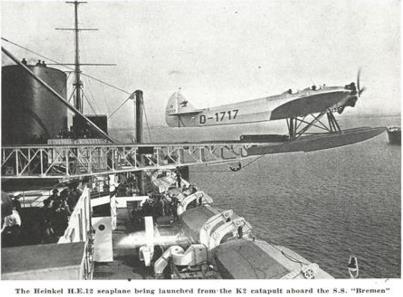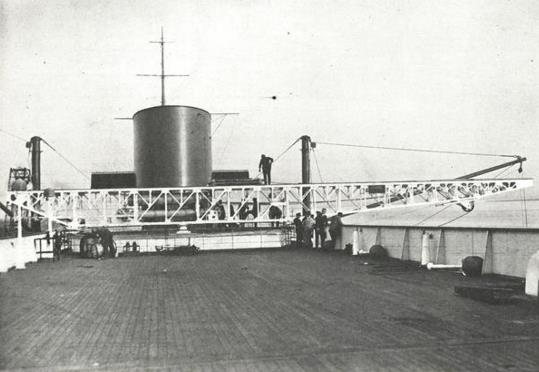AVIATION August 3. 1929
THE HEINKEL K2 catapult installed upon the North German Lloyd liner "Bremen," which figured prominently in the establish-
ment of the recent trans-Atlantic mail record, is the result of two years of experimentation and development by Dr. Ernst Heinkel. its designer. Dr. Heinkel is also the designer and builder of the Pratt & Whitney "Hornet" powered, HE.12, low wing monoplane, which was catapulted from the Bremen at a distance of 20 mi. off shore during the maiden voyage of the new steamship. During the period of development of the catapult, approximately 60 trial starts and a number of improvements were made. These improvements and the original details have been patented in almost all of the principal countries of the world.
The Heinkcl catapult, which on the Bremen is installed on a turntable amidships between the funnels, consists essentially of five units, the turntable, rail bearer or runway, skid or car, compressed air accelerating and testing devices. The maximum weight of the catapult and load is 3,500 kg. (7,700 lb.). The accelerating distance or run is 20 m. (65.6 ft.), while the braking distance for the skid is 3 m. (9.84 ft.). The runway is a riveted structure built up of iron of standard section and is mounted on the turntable so that the start can always be made up wind. The turntable, which lias an angular travel of 180 deg., is actuated by a crank.
As in the case of the U. S. Navy catapults, the starting carriage is fitted with four shoes which slide along the rails on each side of the runway. Jn this respect the Heinkel catapult differs from that built by the Chantiers Company on the French Line Steamship "lle de France." The launching carriage in the latter case was mounted on wheels. (The Ille de France catapult was described briefly on page 336, of Aviation. July 28. 1928.)
A drag cable attached to the front end of the skid passes over junction rollers at the front end of the rail bearer structure and back through a system of pulleys arranged to provide a ratio of approximately six to one between the accelerating distance on the runway and the stroke of the piston, to which the cable is attached. The apparatus is so constructed that the car, after traveling the first meter acquires the full acceleration force. The maximum possible acceleration is 3 g. A quick release hook which holds the airplane in its initial position, opens automatically, and, at the end of the runway, the motion of
the car is arrested by a grip device attached to the upper side of the float bearer and actuated also
by compressed air. The launching speed of the H.E.12 plane from the K2 catapult is 110 km.
(62.2 m.) per hour.
The compressed air actuating mechanism for the catapult consists of a storage cylinder having a
capacity of 2\ times that of the cylinder in which the piston operates. It is of course necessary for the
cylinder to be under a lower pressure before the skid is released so that the drag cable will remain
tight and no jerks will result. The the particular installation on the Bremen, com- pressed air is
furnished from a source of supply on the ship and piped to the catapult.
Control of the releasing mechanism is effected either by the pilot himself from the cockpit or by an
operator on the service stand at the rear of the catapult runway.
One of the original features of the Heinkel catapult is the testing device which eliminates the
necessity of the usual "dead load" test to determine whether or not the catapult is operating
properly. This apparatus consists of a heavy fly wheel of such weight that the force required to
rotate it is approximately equal to that required to produce the desired linear acceleration of the
airplane. This wheel is coupled to a drum upon which the drag cable is coiled and attached by its
free end to the skid. When the pressure in the cylinder is released the skid moves forward, causing
the flywheel to rotate. An automatic releasing device uncouples the flywheel from the drum leaving
it to run free at approximately the same number of revolutions per minute to which it previously had
been brought. The terminal velocity of the skid and the available energy in the accelerating
mechanism can easily be determined on the basis of the reading of a revolution counter attached
to the flywheel and located in a control box at the rear of the catapult structure and below the service
stand.
The seaplane catapulted from the Bremen on its maiden voyage is powered by a 525 hp. Hornet
engine of American manufacture. As previously mentioned the plane is of the low wing, float type
built by the Heinkel Works of Warnemunde, Germany. It has a wing span of 16.83 m. (55.3 ft.) ; an
overall length of 11.60 m. (38.04 ft.) and an overall height of 4.5 m. (14.76 ft.). The weight empty is
1,570 kg. (3,454 lb.), and the gross weight 2,550 kg. (5,100 Jb.). Provision is made for the pilot
and one other person, as well as a large quantity of mail to be carried in the catapult plane.





